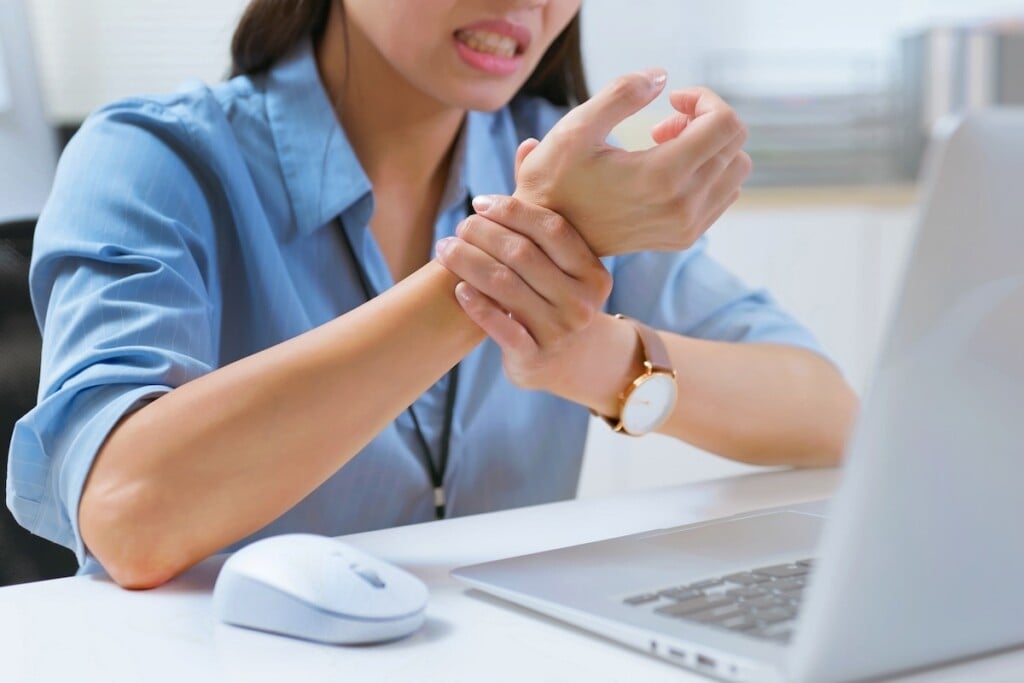You’ve Got Your Nerve
Tingling fingers? Aching wrists? These symptoms could result from pressure on the median nerve in your arm and wrist—carpal tunnel syndrome.

Raise your hand if you’ve been guilty of playing too much Candy Crush Saga or scrolling TikTok for hours before bed. Now, how many of you are feeling numbness or tingling in that hand?
In our increasingly digital world, hand and wrist discomfort has become a familiar issue. If this problem affects you, you may be one of up to 10 million U.S. residents who, according to the American Medical Association, suffer from carpal tunnel syndrome (CTS). The condition is brought on by pressure on the median nerve, which runs from the forearm into the hand. This nerve passes through a narrow space in the wrist called the carpal tunnel. When the tunnel narrows or nearby tissues swell—often from overuse or inflammation—the nerve becomes compressed, resulting in pain, tingling or numbness in the hand and fingers.
Long considered a condition that affected mostly office workers, CTS actually can plague just about anyone who plays sports, works with power tools, drives a car—or does just about any protracted or repetitive daily activity involving arms, wrists or hands.
Design flaw?
“Everyone is at risk of developing carpal tunnel syndrome because the median nerve runs through the palm of the hand, which we all use,” says Daniel A. Seigerman, M.D., an orthopedic surgeon at Hackensack University Medical Center. “The human hand shouldn’t have been made that way—we put so much pressure on our hands and wrists. But here we are.”
Repetitive hand movements are one of the most common triggers of CTS. Long hours spent typing, texting or using a computer mouse can gradually strain the wrist, especially when posture and ergonomics are poor. But jobs and activities involving assembly lines, handheld tools and machinery with constant vibrations can have a similar effect. Even pregnancy can lead to temporary CTS, as fluid retention can increase pressure in the carpal tunnel.
“The symptoms of carpal tunnel syndrome often appear gradually,” Dr. Seigerman says. “Many people first notice tingling or numbness in the thumb, index, middle and sometimes ring fingers, particularly at night. Try using your thumb to touch your pinky: If there’s any pain or discomfort, that’s a sign that you may have it. As the condition progresses, weakness can develop, making it difficult to grip objects or perform everyday tasks like buttoning a shirt or opening a jar.”
Nighttime pain is common, he adds, as many people sleep with their wrists either bent upward or downward, positions that cause increased force on the nerve. “Patients often have difficulty sleeping because of the pain.”
Don’t wait too long
To diagnose CTS, a doctor will usually begin with a physical examination and nerve tests, checking for signs such as weakness in the hand or a delayed response in sensation. Specific tests, such as the Tinel’s sign (in which the doctor taps on the nerve) or Phalen’s maneuver (which involves bending the wrists to see if it reproduces symptoms), are commonly used to determine the source of pain or discomfort.
“Many people will try to power through the numbness and live with the pain,” Dr. Seigerman says. “I see many cases where someone who’s suffering comes in only after a family member or someone else urged them to get checked. Often these patients have late-stage carpal tunnel, and I tell them that I wish they’d come in sooner.” If CTS isn’t diagnosed and treated, he says, it can cause irreparable nerve damage.
Whether or not you experience symptoms, our expert urges preventive measures. “Take frequent breaks from work or repetitive tasks and shake out your hands, which can relieve any pressure from the nerve,” he says. “If you sit at a desk, use a wrist rest with the keyboard and mouse—try your best to keep the wrist in a neutral position. A wrist brace can provide support and reduce undue force on the wrist.” Those who feel discomfort can take anti-inflammatory medications, both over-the-counter or prescribed, which are recommended to reduce swelling.
If symptoms persist, many patients can benefit from corticosteroid injections that target inflammation more directly. Physical therapy also may be introduced, focusing on nerve-gliding exercises and stretches to improve mobility and decrease discomfort. Holistic approaches too can be considered to treat minor CTS symptoms. “Patients can think about doing acupuncture and hand therapy to relieve pressure for mild cases,” says Dr. Seigerman. “You also can increase your intake of vitamins like B12 and B6. [Both vitamins are essential for nerve health.] I’ve found holistic treatments are best for treating carpal tunnel in its earliest form.”
More aggressive treatment may be required for severe cases. When nonsurgical options aren’t effective, carpal-tunnel release surgery may be considered. “It’s usually a 10-minute procedure that opens one of the ligaments to relieve pressure on the nerve,” Dr. Seigerman says. “People think it’s major surgery, but that’s a myth. Really it’s a safe, outpatient treatment in which most patients experience significant improvement.”
The course of treatment depends on the individual, as CTS can affect people in different ways. While CTS-related pain or discomfort originates at the wrist, it can radiate up the arm or even into the shoulder, mimicking tennis elbow or rotator-cuff issues. “Not every patient is a textbook case,” Dr. Seigerman says. “That’s why it’s important not to wait to see a doctor when you feel symptoms, so we can diagnose and understand the problem.”

